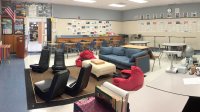Your Flexible Classroom Questions, Answered
We answer the flexible seating questions that many teachers have—like how to keep fire marshals happy.
Your content has been saved!
Go to My Saved Content.Flexible seating is transforming classrooms, enabling new modes of learning, and deepening student—and teacher—engagement. Yet as we saw in a recent Edutopia Facebook post on the topic, many educators have questions about how to make the leap.
How to Handle State Testing in a Flexible Classroom?
Movable tables can be arranged in a traditional testing configuration. This does mean that your computing must be laptop- or tablet-based, but most schools that have gone 1:1 will have this configuration. Sixth-grade teacher and veteran of flexible seating Kristin Harrington says, “At the beginning of the year, flexible seating may be a novelty and could serve as a distraction, but by the time testing rolls around, this environment has become the norm for students. I would advise creating a set space for each student during weekly testing, to ensure that they have a comfortable and safe spot during the state assessments.”
If you have the funding, furniture such as Steelcase’s Verb table with companion whiteboards can increase testing security, and the whiteboards and flexible tables and chairs offer students the ability to share their learning when not in a testing situation.
How to Implement It in Small Classrooms With Lots of Kids?
It’s often easier to accommodate a lot of kids with a flexible configuration. Traditional desks take up a lot of space and aren’t easily adaptable. In an email conversation with me, Harrington recommended bringing flexible seating to the perimeter of the room as well as revamping old closets and other small spaces that would normally be wasted.
How to Convince Your Administration to Do It?
Peter Senge once said, “People don’t resist change, they resist being changed.” I’ve found this to be true with many administrators. Involving them from the beginning is a key to successful administrative support. They’ll want to know the reason you want to change your space. When Brandie Shatto, professor of instructional technology at University of Maryland University College, was trying to get support for a 1:1 program, she found articles about other schools that had had success and sent them to her administrators. “They couldn’t see the benefit at first, so I started sending them one article per week. Pretty soon, they became interested in learning more.”
It’s also important to find out what’s important to your administrators. Harrington says, “Is it test scores? Safety? Personalized learning? Demonstrate how you can still meet all of their guidelines and ensure that their vision for the school can still be met within this environment. Another idea is to have the students write a proposal, explaining how they will benefit from learning in this type of environment.”
There are numerous articles about space and its impact on learning in Edutopia’s Learning Environments topic. Providing your administration and school board with a vision of what others are doing helps promote change in your own school.
How to Pay for the Furniture?
This is always a big concern. Fully remodeling a classroom can be expensive. However, many changes can be made relatively inexpensively. For example, third-grade teacher Sarah Fox at Glen Ullin Public School visits thrift stores and has contacted vendors for donations. Working with your PTA is another excellent way to fund small changes. You might also try connecting the seating to another grant or project. Finally, consider repurposing existing furniture. Harrington notes that “paint can go a long way... as well as shortening legs and adding wheels.” For more ideas on how to make simple changes, get a copy of the Standford d.school’s Make Space. It’s full of ideas for how you can build your own components and is an excellent resource for explaining why you’re making changes.
For something more expensive, teachers have established GoFundMe accounts. However, if you choose this route, make sure to check with your district business officer, as there may be policies or state laws that prohibit this type of fundraising. You can also consider approaching a local business to “sponsor” your space. We already give naming rights for stadiums, and there’s no reason we can’t do the same for our classrooms: “Put your name on our innovative classroom and we’ll make sure you get media coverage.” Once you have secured sponsorship, turn this into a lesson on media literacy to help kids understand how to negotiate and what expectations are acceptable from a sponsor. As with GoFundMe, you’ll want to check with your administration as there may be policies that would limit this. If so, work with them to change the policy.
How to Keep Fabric Clean and Free of Lice?
Another great ally will be your school’s custodial staff. They should be brought in before you purchase anything to tell you what can be easily cleaned, what might take more maintenance, and what to avoid.
How to Keep Fire Marshals Happy?
So you bought some furniture at a thrift store and are having a fire inspection. What to do? I reached out to Deputy Fire Marshal Joe Brant, of the Arizona Department of Fire, Building, and Life Safety. He said that you could take whatever you have to your local fire station for an inspection. He also suggested contacting your facilities department, as they know about pertinent regulations.
